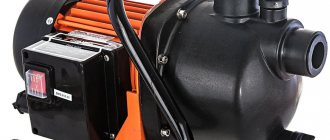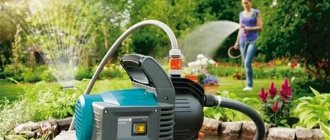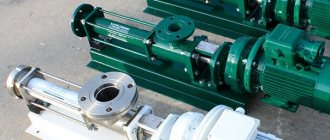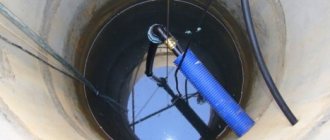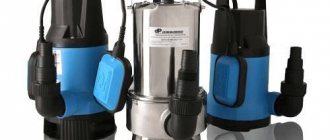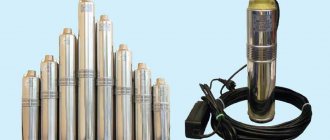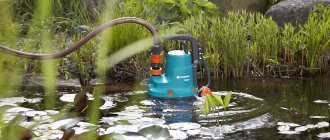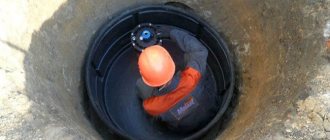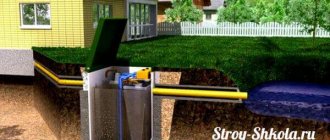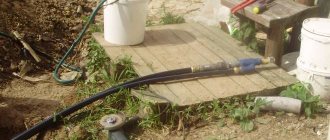Water is the source of life. A person needs it in almost all areas of his activity: in everyday life, industry, etc. Often, the required volumes of water are quite difficult to move manually. Therefore, for a long time, people have used water pumps to pump various liquids. In general, they are divided into two large categories: household and industrial. Their main difference is that the latter are designed to work with large volumes of liquid and have a higher service life.
These two categories are in turn divided into different subtypes. The article will discuss the most popular of them and provide brief characteristics.
Variety of pumps
Structurally, drainers are divided into two large groups: surface and submersible. As the name suggests, submersible models are lowered into water for operation and have the following properties:
- They are characterized by greater power and greater pressure, since they work at great depths.
- She is irritated by noise, since the sound of the operating device is muffled by the thickness of the water.
- Submersible models are characterized by relatively low weight and compact dimensions.
- Reliable and strong, they still require regular maintenance. The reason is the conditions in which the mechanism has to function.
Surface models have the following features:
- They are noisier than submersible ones. Sound is not perceived as a disadvantage, since the unit operates outdoors and not in an apartment, and sound waves are dissipated in space.
- Convenient to use. They do not have to be immersed in the pumped liquid and then removed from there.
- In terms of power, they lag behind submersible models and are not designed to work at great depths.
Submersible pumps have a vertical design Source nasosovnet.ru
Submersible pumps have a wider range of uses, and they are equally useful for both water supply and wastewater disposal. It would be a mistake to consider all submersible pumps to be drainage pumps. If you have little idea how to choose a drainage pump so that it does not turn out to be useless due to technical limitations, it is useful to get acquainted with the classification of drainers. According to the method of application, they are divided into the following types:
- Drainage They are used for pumping and collecting water of varying degrees of contamination. They work at depths of up to 7-10 m, in tanks, basements or in reservoirs.
- Fecal. Structurally, they resemble drainage analogues, but have a greater reserve of power and strength; some models are equipped with a chopping knife. They are used for pumping fecal and heavily polluted water; many models have restrictions on maximum inclusions (for example, up to 35 mm in size).
- Wells. They are engaged in pumping clean water (inclusions no more than 5 mm), can work at different depths; lifting height starts from 7 m.
- Borehole. Designed for operation at great depths, therefore they are distinguished by high power, operating pressure and productivity.
Scheme of operation of a well drainage pump Source kolodec.guru
Selecting and connecting a drainage pump: recommendations from experts
Following the recommendations of our portal, many country homeowners have already installed a drainage system on their site and know how to drain water from the basement. We continue the series of articles devoted to drainage. Last time we explained the nuances of installing a drainage well, today we will tell you how to choose the right drainage pump.
From our material you will learn:
- Why do you need a drainage pump?
- How is it different from fecal?
- What are the types of sump pumps?
- How to calculate the required amount of pressure.
- Which hose to connect?
What is a drain pump used for?
Owners of suburban areas are often faced with the need for drainage. This problem usually gets worse in the spring, a time of heavy snowmelt. Excess water leads to flooding of the site, ditches, basements and has a detrimental effect on the root system of many plants. In this situation, a drainage pump comes to the rescue - equipment designed to pump out contaminated water and wastewater. With the help of a “drainer” you can drain a foundation pit dug under a foundation flooded by rain, “throw” excess water off the site, save a cellar from flooding, and eliminate the consequences of a pipeline break in the basement.
Moreover, as the experience of our users shows, the device will help out even if a full-fledged drainage system has not yet been installed on the site.
Barav FORUMHOUSE user, Moscow.
I needed the “drainer” to pump out water from the site and pump out a well 5 meters deep. I chose the most common pump - without any bells and whistles. When purchasing it, I was guided by the principle: price-quality. Anticipating the question of why I decided to pump the water out to pumps, rather than equip a full-fledged drainage system on the site and, thereby, save it from flooding, I will answer: doing something haphazardly is more expensive for yourself. I made a drainage project and calculated that the estimate would exceed 150 thousand rubles. For now, I put off its construction “for later”, and do what everyone else does - “budget” drainage - bury the money in the ground. I don’t want to redo it in 2-3 years.
Guided by these principles, Barav decided, as a temporary measure, until full drainage was launched, to drain the water with a drainage pump. To do this, he additionally purchased a hose 25 meters long, with a cross-section of 1 inch, and a reinforced rigid hose 6 meters long, with a cross-section of 1 ½ inches. According to our user, he had to tinker with connecting the hose because... the hose did not fit into the fitting. As a result, Barav managed to install a 31-meter-long system, which he decided to use to pump out water.
He dropped the “drainer” into the deepest place of water on the site and turned it on. The result of the work is visible in the following photos.
Flooded area
Working drain pump
Result of work
Barav
I “drove” the pump in full. I pumped everything out to them - the drainage well, the neighbor’s basement, and the drains from the kitchen. He “plowed” 5-8 hours a day all summer and autumn. Moreover, it worked so silently that I sometimes went up and checked if it had turned off.
In total, the drainage system worked for 7 months. This is approximately 800 hours and during this time it pumped about 8,000,000 liters of water, and the device even had to pump out a mixture of water and clay with sand from the pit.
Barav
I operated the pump in the harshest conditions, in very dirty water, even with “dry running”, which caused it to break. The “autopsy” showed that the engine was flooded with water, which got there due to the fact that the air outlet hole was clogged (it is located under the float mount), which had to be cleaned periodically.
Despite this ending, our user decided to buy a new “drainer”, but now strictly adhere to the rules of its operation .
Basic principles for choosing a drainage pump
We know that a drainage pump is designed to pump contaminated water from ditches, pits, drainage wells, basements, etc. It would seem that now all that remains is to go to a hardware store and buy it. This is where there are several pitfalls that you should be aware of in advance. The first of them is that the market offers a huge selection of drainage equipment. To choose the device that's right for you, you need to narrow your search criteria. To do this, you need to answer the following questions.
What is the difference between a drainage pump and a fecal pump?
Indeed: both drainage and fecal are designed for pumping dirty water and wastewater. Those. — liquids containing various inclusions. So why not pump out both the septic tank and the pit in the foundation pit with one. Not so simple. The purpose of the pump depends on the composition of the wastewater, its temperature, and chemical composition. Let's consider this aspect in more detail.
Drainage pumps are designed for pumping out wastewater containing solid impurities (inclusions) of a certain size - usually from 5 to 40 or more millimeters. The permissible size of solid particles that can pass through the mechanism is specified in the instructions . To protect the mechanism from the ingress of large solid objects - stones, gravel, etc., larger than those established by the design, the suction part of the device is protected with a metal mesh.
The fecal pump (if it is equipped with grinder knives intended only for grinding organic debris and fibrous inclusions) is used for pumping water that does not contain suspended solids , because it does not have a filter that delays such inclusions.
Most drainage pumps are designed to pump water with a temperature not exceeding 35-40°C. Therefore, if the device is needed to pump out hot wastewater (from the kitchen, bath, sauna, dishwasher), or you need to drain a basement flooded with hot water due to a break in the hot water supply system, you must choose a “drainer” designed to work in such “hard” conditions. » conditions. Those. with a temperature allowing its operation at 70°C and above degrees.
It is important to take into account the chemical parameters of the pumped water. If the pump will operate in an aggressive environment, the materials from which it is made will be subject to increased corrosion-resistant requirements. There are also drainage and fecal devices designed for both pumping fecal and wastewater containing solid inclusions.
Therefore, before purchasing, first carefully read the instructions - why, in what water and what inclusions (particle size) the device can pump.
You should not try to use the “drainer” as an element of the water supply system of a country house, because... pumps of this type do not create enough pressure.
We remember that submersible pumps designed to work in clean water (to supply water from a well) are not designed to work with dirty wastewater.
What are the types of sump pumps?
To simplify the choice, they can be divided into 2 groups:
- Working on the surface.
- Submersible.
From the names it is clear where the “drainer” works. The surface one is placed next to the place where water is pumped out. Then a hose is lowered to the bottom of the well or drainage hole, through which the waste is pumped out. The device operates in automatic mode. When the liquid level rises to a certain value, due to the float (rising along with the liquid), the pump turns on and begins to pump out water. But submersible devices have become more widespread, as they are the most convenient to use. They are completely lowered into the pumped liquid. Unlike a surface “drainer”, such a pump is not afraid of precipitation and moisture, which means it is better suited for work on the site and is not affected by negative atmospheric phenomena.
Important: the submersible pump (its motor) is cooled by the liquid in which it operates. To protect against “dry running” - “work without water”, submersible pumps are equipped with float switches. The float turns the device off and on when the liquid reaches a certain level.
When installing the pump, make sure that the float has the so-called. free “working stroke”. Did not cling to the walls of the well, branches, edges of the pit, etc. Another important characteristic of the “drainer” is the level of emptying (it is prescribed in the instructions). Those. what level of water can remain at the bottom of the container, after which the pump will stop pumping it out. This value can be ≈ 20-50 mm. A device with such parameters can be in demand when it is necessary to drain small flooded rooms and containers almost “dry”. The pumped water should not contain large abrasive particles.
What are the main criteria for choosing a drainage pump?
When choosing a “drainer” you need to pay attention to two main characteristics:
- Capacity l/min or m³/hour. Those. the amount of liquid pumped over a certain time.
- Pressure This value shows to what height (the difference in height between the installation site and the discharge point) wastewater can be pumped out. This parameter affects the ability to pump wastewater over a certain distance.
Let's look at the second parameter in more detail.
XxxlFORUMHOUSE user
I want to buy a drainage pump. I need it to pump water out of the pool. The height of the pool is about 1 meter. I began to study the technical characteristics of the pump I liked and saw the following parameter: maximum pressure - 14 meters. I want to understand what this parameter means and how far the device can drain water.
Andrey 203 FORUMHOUSE user
This parameter shows to what height the pump will raise water. We also take into account pressure losses when overcoming the hydraulic resistance of the pipeline.
Hence: for the calculation we need to convert the vertical to horizontal. Approximately the horizontal pressure loss ratio will be 1:10. Those. 1 meter of vertical pressure is equal to 10 m horizontally.
This coefficient = 0.1. Based on these data, we solve the following problem:
The “Drainer” was installed in a well at a depth of 5 meters, the length of the pipe for drainage is 20 meters, then the water will flow into the ditch. The minimum pressure is: 5 + (20 * 0.1) = 7 m. We need a pump with a pressure of at least 7 meters. To “insure” and obtain guaranteed pressure at the outlet of the pipe, you can add another 3 m to the resulting figure. That is. - a pump with a pressure of 14 m, this is ≈ 140 m horizontally.
It is also important to choose a hose of the appropriate diameter, because... By lowering its cross-section, we will “strangle” the pump by attaching a ¾ hose to it.
Andrey 203
If the pumping time is not working, then you can install a three-quarter ¾ (≈ 19 mm) hose; if you need to pump out water quickly, then an inch and a quarter 1 ¼ (≈ 32 mm).
Sergey N FORUMHOUSE user
If you need to quickly pump out water, then do not skimp on parameters (power) and think about a larger diameter pipeline.
Tip: if you need to connect the drainage temporarily - mobile, you can use a rubber reinforced hose. For a stationary, permanent connection, you can use 40 mm HDPE pipes.
Our article describes in detail the features of installing HDPE pipes.
Xxxxl
In the end, I bought a pump with a maximum head of 9 m and a max. productivity 12 m³/hour. It is suitable for hoses from 1 inch and above. I took a hose with a diameter of 32 mm and a length of 25 meters. I lowered the pump into the pool at 14 m³. It pumps well, but the hose is hard to carry. Then I left a 3-meter inch hose (the part that comes from the pump), and to it, through a tee, I connected a ¾ by 20 meter hose.
Our user needed an adapter to make another ¾ bend. It took about 3.5 - 4 hours to drain the pool and water the trees (with a ¾ hose). If pumping was carried out through a 1-inch hose, then, according to our user, the pool would be empty in 1.5 hours.
Conclusion: There is no one universal sump pump that fits all situations. Each situation must be considered individually and the appropriate equipment must be selected.
In the topic on the FORUMHOUSE website you can get advice on choosing a drainage pump and learn how to independently determine the groundwater level in your area. We also suggest watching a master class on installing a submersible pump and finding out how to choose a hose for a drainage pump.
Our video talks about how to build a basement with a high groundwater level; you can also see all the nuances of constructing a drainage system.
Drainage pump: features and design
Ratings of drainage pumps are compiled annually, taking into account the technical characteristics of various models. However, despite the difference in parameters, they are all capable of coping with many tasks of pumping clean, rain, melt, drainage, and ground water, namely:
- Drain slightly contaminated or waste water from a pit, swimming pool, or drainage ditch.
- Remove water from a reservoir, well or open pond for watering plants or cleaning the area.
- Pump out sewer water (some models).
- Pump out water with impurities (silt, clay, suspended sand and dirt) from the basement after flooding.
The difference between submersible drainage pump models and their surface counterparts is their greater power and performance; their cost is also higher. The unit structure includes the following elements:
- Frame. It is made of stainless steel or impact-resistant plastic, contains an electric motor and a suction unit.
Drainage pump and its components Source storgom.ua
- The engine is most often located vertically. An impeller (impeller) is attached to the electric motor shaft. As the wheel rotates, it creates a pressure difference; under the influence of centrifugal force pressure, the water flow moves into a pipe or outlet hose.
- The pump unit is equipped with an intake pipe and a grill. Its purpose is to filter out large particles that can harm the device. The diameter of the holes in the grid determines the size of particles that the unit can handle.
- The pump kit includes an electrical cable (at least 10 m), which facilitates the use of the unit.
When deciding which submersible pump for dirty water is best to choose, it is useful to determine the scope of its use. The fact is that the device is specific equipment, and it is not recommended to use it for other purposes. For example, it can be used to clean a shallow well, but this should be a one-time task; such a pump is not intended to operate in a well. Also, a submersible drainage pump cannot be used for pumping out sewage - it will quickly fail.
Pumping groundwater from the basement Source drydesigns.co.uk
See also: Catalog of companies that specialize in engineering systems (heating, water supply, sewerage and others) and related work
In what cases are pumps used to pump water?
Situations when we need a special pump to pump out dirty water are usually typical:
- Pumping fecal water from septic tanks.
- Elimination of consequences of utility accidents.
- Pumping out drainage water.
- Maintenance of swimming pools and garden ponds.
- Watering plants with groundwater from surface sources.
- Used in fire fighting for drawing water from fire reservoirs.
- Application in various production processes, etc.
At the same time, the meaning of the word “dirty” water should not be misleading. A special pump may be required even if drinking water is pumped from a well or spring, since the sand content in this water will be so high.
Trade offers a huge selection of pumps for pumping out dirty water from different brands and manufacturers. Therefore, its acquisition should begin by studying information about them. Time will not be wasted on this; this way you will be able to choose the right pump correctly and then use it correctly.
Characteristics
When comparing different models to determine which sump pump is best, it is important to remember that standard units have several common properties:
- Pollution should be light. During operation, the volume of solid impurities inside the drainer should not exceed 10%.
- The size of particles in the impurity for different models ranges from 3-40 mm.
- The devices are not intended for pumping hot water; household models are designed for an operating temperature of a maximum of 35-40°C. If the heating plant breaks, the standard pump cannot be used. The possibility of pumping hot water is indicated in the instructions.
The particle size is determined by the size of the hole through which the device draws water. Therefore, size is an indirect parameter by which you can understand what kind of water the pump is intended for:
- Impurities up to 5 mm. The device can handle lightly contaminated water from a swimming pool, irrigation tank or other reservoir with a low content of foreign particles.
- Impurities up to 30 mm. The pump will be able to drain a flooded basement or pit (under the foundation).
Each pump is designed for a certain level of impurities Source ytimg.com
- Impurities up to 50 mm. The unit is suitable for pumping melt, rain, and waste water from pits, ditches, and lowlands on the site.
If you plan to pump water from a depth of more than 5 m, then a surface pump will not cope with this. You will need a submersible unit whose technical characteristics are described as follows:
- Electric motor power. The most important characteristic on which performance depends. For domestic needs, models with a power higher than 1 kW are rarely purchased; usually it ranges from 300-800 W. In some instances the power reaches 1.4-2 kW.
- Performance (throughput). Shows how many liters the pump pumps per minute or hour. Household models pump 150-250 l/min (up to 15 cubic meters per hour), some have a capacity of 400-500 l/min.
Pump for pumping out a septic tank Source my-farmer.ru
- Height of water rise. The pressure is easy to determine for a well; for other cases a calculation is needed. For example, if you have to pump out a basement 3 m deep, but a hose with water needs to be laid along the area (15 m horizontally), and then thrown over a fence 2 m. The required pressure is obtained from the addition: 3 + 15 x 0.1 + 2, where 0 ,1 – coefficient for horizontal sections. The value of 6.5 m is the pressure required for this task.
- Immersion depth (pump). A technical characteristic that should not be confused with lifting height; as a rule, they do not coincide. The immersion depth can be either greater or less than the lifting height; this should be taken into account when studying the technical passport.
- Material. Sometimes water contains active impurities (chemicals). Manufacturers take this possibility into account and use materials in production that are resistant to aggressive environments and corrosion. Stainless steel or especially durable plastic is selected for the body. Under normal conditions, the materials behave almost identically, but in an aggressive environment, stainless steel is preferable, and such a pump will cost more.
The metal case is more reliable in operation Source pearl-kamchatki.rf
- Water resistance. One of the characteristics is the degree of protection, which is expressed in international classification, for example, IP68 or IPX8 marking.
- Minimum residual liquid level. No more than 40-65 mm.
- Hose. The hose is selected separately, and it is important to ensure that its diameter matches the diameter of the pump nozzle.
It is important to remember that running dry without water, even for a few minutes, can damage any pumping equipment. To protect against dry running, drainage pumps are equipped with a float switch. It is an important and reliable element of automating the process and protecting the mechanism from damage. The float switch has two operating modes:
- When there is a lot of water. At this moment, the mechanism is turned on (the contacts are in a closed state), and the pump continues to function.
- When the level drops to critical. The float drops, the contact opens (a steel ball is used for this), the engine stops.
Float switch operation diagram Source ampika.ru
Popular models and prices
The most popular and at the same time practical and functional pump models include the following pumping units:
Surface pump Pedrollo
- Pedrollo NGA from a well-known Italian manufacturer - pumps designed for installation indoors and under sheds. The machines are capable of operating at external temperatures down to -10° C, while the temperature range of the pumped liquid is from -10° C to +90° C. The design feature is the presence of an open impeller, thanks to which the pump is able to pump heavily contaminated liquid. The stainless steel wheel is resistant to corrosion and the abrasive effects of solid particles. Features of operation include the need to fill the system with water through a special hole before starting. The price of the pumps is 17.2-17.6 thousand rubles.
- Calpeda C machines are also of Italian origin. They have proven themselves to be reliable and unpretentious pumps designed for pumping liquids with an average content of impurities (linear size up to 4 mm). Depending on the performance characteristics, they can have a cost from 14.6 thousand rubles (power - 0.15 kW) to 28.8 thousand rubles. (1.1 kW).
Criterias of choice
Performance characteristics are the main information when evaluating different models of gray water sump pump; To choose the option that's right for you, you should follow the following strategy:
- Rely on key parameters: power and pressure. For country needs, 5-10 cubic meters per hour is quite enough, and for watering beds you can get by with 0.4-0.6 cubic meters.
- Pressure helps you understand how far you can transfer water. Keep in mind that 1 m vertically approximately corresponds to 10 m horizontally, so it is useful to measure the distances on the site in advance.
Pumping water from the basement Source samstroy.com
- If you compare models based on performance, consider the time it will take to complete a particular task, and focus on the most difficult task.
- The choice of manufacturer is a matter of personal preference of the owners. Some trust only well-known (and, preferably, foreign) brands, while others find models with a good price/quality ratio from domestic manufacturers.
Advice on choosing a pump
To determine the required technical characteristics, you can use some rules:
- Capacity is easily calculated by dividing the volume of liquid being pumped (for example, a garden swimming pool) by the time during which this volume must be moved (pumped out). More efficient pumps have higher power.
- to assess the pressure characteristics if you consider that each meter of lift corresponds to 10 meters of horizontal liquid transportation. Thus, despite the partial truth of the statement that the pressure should be less, the shallower the depth of the reservoir or reservoir, it is worth including in the calculation the need to move the pumped liquid over a certain distance.
Rating
In suburban areas, far from the benefits of civilization in the form of water supply and sewerage networks, the pump is a source of familiar comfort, and its choice is approached especially carefully. Help in choosing is provided by ratings of drainage pumps for dirty water, which are compiled by both specialists and ordinary users.
Watering the garden is one of the functions of pumping equipment Source grounde.ru
Device
The most common drainage pumps are the following designs:
- Centrifugal: the pumped medium is spun by the impeller, as a result of which centrifugal force begins to act on it. Thanks to it, the liquid rushes into the outlet pipe with strong pressure. Unlike pumps for clean water, drainage units have an open impeller, which helps avoid jamming when pumping water with impurities. The maximum particle size for most surface centrifugal gray water pumps is 10mm.
- Screw: according to the principle of operation, this pump resembles a conventional meat grinder - liquid is supplied from the suction pipe to the discharge pipe using a screw. Such units are capable of pumping highly contaminated liquids with high viscosity and large inclusions. Most fecal surface pumps for dirty water are screw pumps. They are often used to organize irrigation of garden plots with water from natural reservoirs, even very dirty ones. In this case, watering is combined with fertilizer, since fertile silt, as well as crushed algae, leaves and various organic debris will fall onto the site along with water.
- Diaphragm: the suction and discharge pipes of such a pump are equipped with valves, and the liquid is pumped by a flexible membrane that oscillates. The membrane itself is attached to a magnet, which is driven by an alternating magnetic field. In industry, fire-resistant diaphragm pumps are used - in them the membrane is driven not by electricity, but by compressed air. The pumped medium may contain particles up to 50 mm in size.
The main purpose of diaphragm pumps is pumping viscous liquids.
Video description
About the Grundfos Unilift Kp 250 m1 pump in the following video:
- AL-KO Dive 6300/4. A high-pressure pump with a capacity of up to 6300 l/h and a maximum flow of 40 m, suitable for use both in irrigation systems and for installation in a well. The device is designed for long-term operation, as evidenced by the stainless steel motor shaft. One of the disadvantages is the problematic check valve.
- VORTEX DN-900. The unit is used for pumping clean, rain, drainage, and groundwater. The advantage is its power of 900 W, a throughput of 15.5 cubic meters per hour, as well as protection against dry running and overheating. The disadvantage of the model is the leaky housing, the reason for frequent repairs and relatively quick failure.
- PATRIOT F 850. The vertical immersion model is designed for pumping dirty water (with impurities up to 35 mm). The advantages include automatic silent operation, a stepped diameter of the outlet pipe, and excellent engine tightness. Cons: the float can become clogged with silt, the body is made of plastic, the impeller is also plastic and therefore fragile.
High pressure pump AL-KO Dive 6300/4 Source vencon.ua
Scope of application
Unlike pump models designed for lifting and transporting clean water through pipelines, a pump for contaminated liquids is not afraid of hard and soft insoluble inclusions . Nevertheless, the capabilities of the models are different - while some are capable of pumping water with sludge, others are able to cope even with thick viscous compositions, essentially liquid mud. This point must be clarified at the selection stage, taking into account the intended scope of application of the pump.
In a private house or country house, a surface centrifugal pump for dirty water can be used for:
- draining a basement or cellar during a flood or in the event of an emergency,
- pumping liquid from inspection wells,
- drainage of storage or drainage ditches and pits,
- draining pools, fountains, artificial reservoirs when cleaning, repairs are necessary or before the onset of winter,
- supply of partially purified or ground water from pits or drainage pits (wells), storm water storage tanks for watering plants,
- installation of an irrigation system using a natural reservoir,
- draining pits during the construction of a house or outbuildings, if groundwater is located high on the site.
Briefly about the main thing
Drainage pumps, originally created for draining basements, have now significantly expanded their scope of application. They can be found in wells and swimming pools, cleaning pits, basements, and pumping wells.
Submersible models have an advantage over their surface counterparts when lifting water from a well, but they are more difficult to maintain. In a suburban area, drainage specialists are responsible for a lot of work, which is why a competent approach to their selection is so important.
When comparing different versions of devices, pay attention to their main characteristics: power, height of water rise, ability to pump impurities. A suitable model is determined based on the type of work planned; for large volumes of work, pumps with a stainless steel housing and motor shaft are preferred.
Ratings 0

